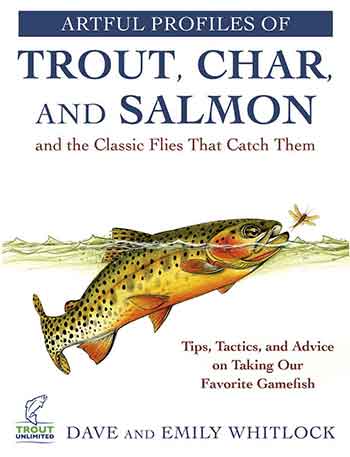Trout Flies
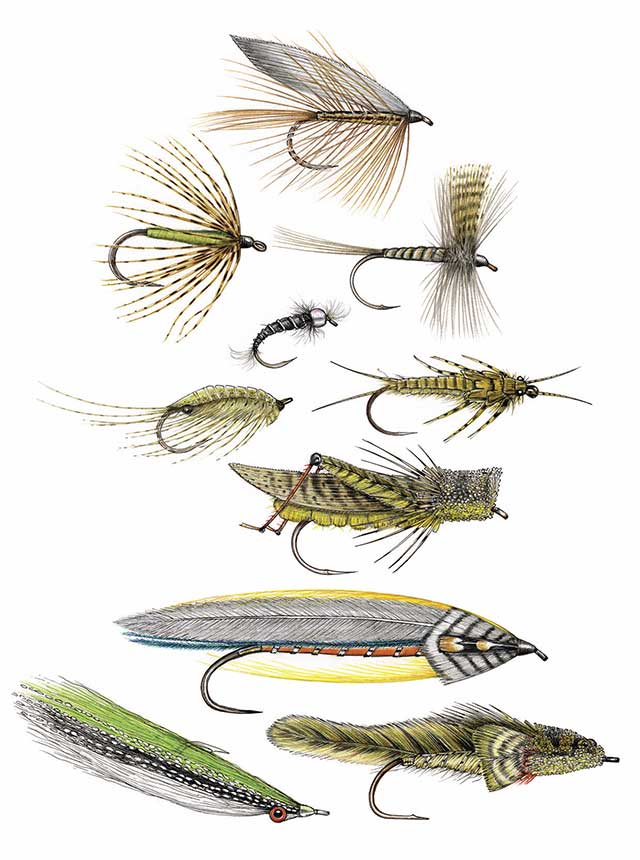
Trout feed on an awesome variety of food forms and so a typical fly selection should include wet flies, soft hackles, dry flies, midges, crustaceans, nymphs, terrestrials, streamers, lead-eyed streamers, bottom minnows.
Trout flies have always been a fascinating mix of practical function, unique sculptural form, and hypnotic beauty to me. In the next few chapters, I’d like to discuss wet flies, dry flies, nymphs, emergers, crustaceans, terrestrials, streamers, bottom dwellers, and exciters/attractors, and how I see their evolution, from historic, to traditional standards, to new designs. The materials, performances, and effectiveness will receive my analysis, as will their colors and forms through my pens, pencils, and paints.
As you know, most trout flies are imitations of some form of live trout food. I believe the term fly evolved from a general British description of insects, much like Americans use the word bugs. Originally, most trout flies were imitations of aquatic insects, both mature and immature. However, as the sport of fly fishing spread and evolved to many places in the world, and as more fly fishing was done throughout the entire four seasons, flyfishers recognized that trout indeed feed on much more than just aquatic insects. Paralleling this, flyfish ers slowly accepted that it was good sport to fish flies not only on the surface, but throughout the entire water column of streams and lakes.
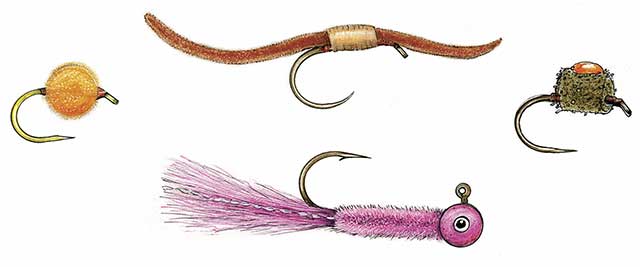
Flies not usually considered standard trout food imitations: eggs, worms, pellets, microjigs.
During my lifetime, in order to reach deeper depths and fish swifter waters, many American trout flies have been gradually tied with heavier and heavier materials, for example, copper wire, and heavier materials, for example, copper wire, and heavier materials, for example, copper wire, bead chain eyes, lead wire, lead eyes, and very dense tungsten beads are employed (as well as using split-shot and fast-sinking fly line) to get these flies down deep. As this “weight race” began, many older flyfishers on both continents strongly objected. I remember that Lee Wulff, perhaps our most acclaimed wild trout conservationist, argued that trout and salmon need water depth for sanctuary to survive our fishing efforts. Weighted flies and fly lines have taken much of that away from them. There are still a few trout and salmon waters (mostly in Europe, but also in America) where weighted flies and lines are forbidden.
So, the simple definition of a fly has changed greatly over time and has gotten much more complex.
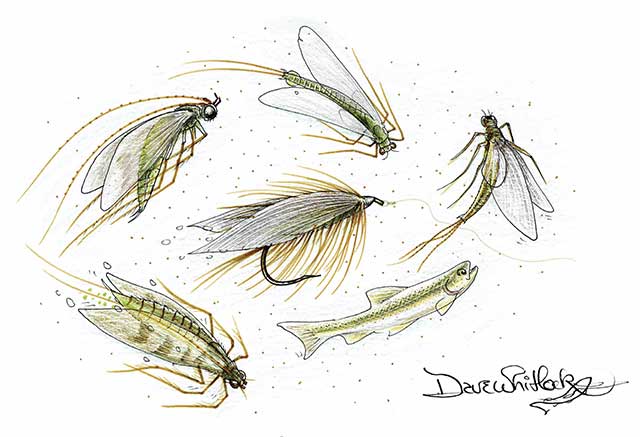
A trout fly can simulate several food forms. The ones that suggest the widest variety of foods often become standards or classics.
When I was eight years old, I didn’t realize it but I began making fly-like lures when I’d run out of worms, bacon fat, crawfish tails, or whatever bait I was able to find for catching bluegill and bullheads on my cane pole. I’d tie bits of grass, feathers, rubber bands, and other odds and ends to my long-shank cricket hooks, using red sewing thread I’d get from my grandmother. By gosh, these crudest of imitations worked pretty well! I’ve been designing and tying flies ever since, without any lull in my enthusiasm.
Through my teens and early twenties, I continued to create flies that worked for me with what limited tools, materials, and instructions I could find in the 1940s and 1950s in Oklahoma. This self-educating process proved to be a minor handicap—and a major advantage—during my lifetime as a creative trout fly designer and tier. One of my first impressions about trout fly tying, after learning about many of the famous trout flies, was that they had to be constructed of only very specific natural animal feathers and hair, such as otter, jungle cock, and wood duck.
I considered these materials to be almost sacred and magical in their ability to imitate live trout foods. Yet my “home-made,” unorthodox flies, spun with the hair from local rabbits and squirrels I hunted and barnyard rooster feathers, would also catch trout—at least in the stocked streams in Missouri state parks and in the Smoky Mountain streams I personally could reach from Oklahoma.
As I matured into my early thirties, I realized a couple of important facts. One, many of these “famous trout flies” had been constructed by early tiers using, like I had, materials that were available to them locally. Second, I could use synthetic materials that would be similar in color, texture, and physical dimensions to the natural materials. Synthetics signaled a departure from traditional materials, and that took some time to be accepted by the majority of older tiers and flyfishers. But these materials became more and more important as the supplies of natural, wild materials around the world dwindled and/ or they became unlawful or unethical to collect or sell. Today, most naturals are raised or legally hunted specifically for the garment industry or fishing-lure market.
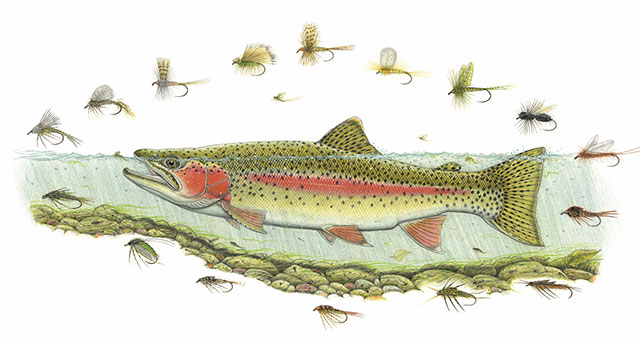
The hallmark of fly fishing for trout is to try to match the natural foods on which they are feeding. I call this piece “Hatches and Matches.”
Although I still love to tie with natural materials the most, I have extended my fly designing significantly with synthetic hair, furs, foams, silicone, latex, Mylars, wires, paints, molding compounds, nylon threads, and plastic eyes. I would not want to go back to those limiting days of using only natural materials. I want my designs first to cater to trout, but at the same time, to be attractive to flyfishers as useful and durable artistic sculptures of trout foods.
Excerpted with permission from Artful Profiles of Trout, Char, and Salmon and the Classic Flies That Catch Them (Skyhorse Publishing, 2018). Copyright © 2018. All rights reserved.
